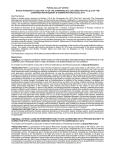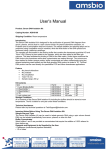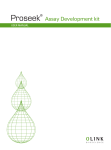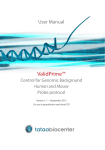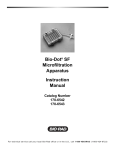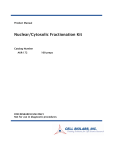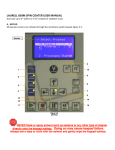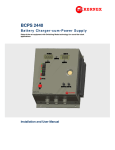Download USER MANUAL Rocket Immunoelectrophoresis Kit
Transcript
USER MANUAL Rocket Immunoelectrophoresis Kit Catalog No: IMI-KIT-1009 – for 5 experiments Duration – 3 hours Rocket Immunoelectrophoresis Kit contains Standard reagents and Protocol An ISO 9001:2000 Certified Company IMGENEX INDIA PVT. LTD. E-5, INFOCITY, KIIT POST OFFICE BHUBANESWAR-751024 Tel: 0674-2743265, Fax: 0674-2741046 E-mail: [email protected] Website: www.imgenexindia.com Rocket Immunoelectrophoresis Manual Rocket Immunoelectrophoresis Kit I. PRINCIPLE Antibodies are produced by the immune system in response to foreign macromolecules. Each antibody binds specifically to one epitope on an antigen. This allows the use of antibodies for the detection and quantification of specific proteins in complex mixtures. Antibodies are generally isolated from animal serum, unless they are produced from tissue culture as monoclonals. The serum must be titrated to determine antibody concentration and specificity. Concentration determinations are often needed for antigen mixtures as well. Rocket immunoelectrophoresis is useful technique for these purposes. Rocket Immunoelectrophoresis is a quantitative method for serum proteins which involves electrophoresis of antigen into a gel containing antibody; the technique is restricted to detection of antigens that move to the positive pole on electrophoresis. It is a rapid way to quantify antigen in complex samples. As the antigen proteins enter the gel, they form a concentration gradient, which at some point gives the proper concentration for precipitation with the antibody in the gel. The more concentrated the antigen, the further it must run to be diluted to precipitable levels. The result is that each sample gives a “Rocket”, the length of which is proportional to the concentration of antigen in the sample. In the clinical laboratory, this technique is used diagnostically. It is utilized in examining certain serum abnormalities, especially those involving immunoglobulins, urine protein, cerebrospinal fluid, pleural fluids and other body fluids. In research, this procedure may be used to monitor antigen or antibody, to detect impurities, analyze soluble antigens from plant and animal tissues, and microbial extracts. II. OVERVIEW "Quantification of proteins by electrophoresis into agarose containing the corresponding antibodies has received the nickname rocket” (immuno) electrophoresis because the precipitates formed when the migrating protein antigens are precipitated by the antibodies resemble upright rockets. Here antiserum is included in the gel matrix as a result immuno precipitates will form, in a pattern dependent upon the antigen concentration. This technique is much faster than immuno-diffusion, and has been applied in a variety of geometries, to analyze simple or complex samples Agarose gels used in this technique have a small number of fixed charges, which cause a phenomenon known as electroendosmosis. EEO causes a slow net flow of water through the gel away from the positive electrode. At a pH of 8.5, antibodies are nearly uncharged, and their slow electrophoretic migration is nullified by the EEO flow through the agarose. III. ADVANTAGES • • • • This method is rapid, reliable, specific, and extremely accurate. This Kit helps the student to understand the principle and basic function of this technique. It is used to determine the concentration of antigen in a complex mixture. Contains Standard reagents and protocol for better results. [email protected] 2 www.imgenexindia.com Rocket Immunoelectrophoresis Manual IV. KIT COMPONENTS AND STORAGE All the reagents should be stored at 2-8°C when not in use. Sl No Components Quantity 1 Agarose 1.5 g 2 10X Assay Buffer 125 ml 3 Antiserum 1.9 ml 4 Test Antigen with dye 150 μl 5 Standard Antigen (A, B, C ) with dye 6 Glass plate 150 μl each 1 Additional items required (not included in the kit) Glassware: Conical flask, Measuring cylinder. Reagents: Alcohol, Distilled water. Other Requirements: Electrophoretic apparatus, Micropipette, Tips, Gel puncher. V. PREPARATION OF REAGENTS NOTE: Included buffers and reagents are optimized for use with this kit. Substitution with other reagents may not give optimal results. Assay Buffer: Prepare 1X of Assay Buffer by diluting it with distilled water (Add 450 ml of distilled water to 50 ml of 10X Assay buffer provided). The diluted 1X Assay buffer may be stored at 4°C. However, we recommend preparing fresh 1X Assay buffer as per experimental requirement. Clean the glass plate, electrophoretic apparatus with alcohol thoroughly to make it grease free and for even spreading of agarose. Concentration of Standard Antigen: 2 mg/ml (A), 1 mg/ml (B), 0.5 mg/ml (C). VI. PROTOCOL (FOR 1 EXPERIMENT) 1. Prepare 10 ml of 1.0% agarose in 1X Assay Buffer by heating slowly till agarose dissolves completely. Take care not to froth the solution. 2. Allow the molten agarose to cool to 55°C. 3. Add 350 µl of antiserum to 10 ml of agarose solution. Mix gently, ensure uniform distribution of antiserum. Note that temperature of molten agarose is around 55°C while adding antiserum. Higher temperature will cause denaturation of the serum proteins while lower than 55°C will cause the gel to set prematurely. 4. Pour the mix onto the glass plate (8 cm X 7 cm approximately) placed on a horizontal surface and allow it to solidify. [email protected] 3 www.imgenexindia.com Rocket Immunoelectrophoresis Manual 5. Place the glass plate on the stand in the electrophoresis apparatus. 6. Punch ~4 mm diameter 4 wells with gel puncher or 200 µl micropipette tip towards one end of the plate as shown in the template. Standard A Standard B Standard C Test Antigen Figure 1. Template for Rocket Electrophoresis 7. Remove agarose gel plugs with a toothpick or forceps. 8. Transfer the stand containing the gel to the electrophoresis apparatus; ensure that the wells are towards the cathode. 9. Gently lay the filter paper wicks over the ends of the gel, (they should overlap about 3 to 4 mm) and allow them to become saturated with electrode buffer. 10. The wicks should be submerged in the buffer. Press on the wicks to ensure good contact between the gel and the Assay buffer. If necessary, add more buffer, but take care not to submerge the gel. 11. Load 20 µl each of the given standard antigen and test antigen to the wells. Loading of wells should be carried out quickly to minimize diffusion from the well. 12. Carefully, connect the cord of the electrophoresis apparatus; insert the cords into the power supply with the black cord in the black (negative) input and the red cord into the red (positive) input. 13. Turn on and set the power supply for the required voltage (60 Volts). To ensure proper current flow check for bubbles formed on the electrodes. 14. Electrophorese the samples, till the rockets are visible or the dye front reaches the edge. This generally takes 2 to 2.5 hrs. Electrophoresis can be continued for an additional 15-20 minutes after the dye has run out of the gel. This ensures better visibility of the precipitation peaks. 15. After electrophoresis is completed, turn off the power, unplug the power source, disconnect the cords, and remove the glass plate from the electrophoresis tank. 16. Observe the precipitation peak or rocket formed against a dark background. Measure the rocket height from the upper edge of the well to the tip of the rocket. Record your observations. Note: If the rocket formation (precipitation) is not visible, incubate the plate at 37°C in a moist chamber overnight). Note: For better visibility the gel may be stained with Coomassie Brilliant Blue (CBB) stain for 1520 minutes and then destain it with CBB destain for 24-32 h or till the rocket peaks become visible. 17. Construct a standard graph by plotting the height of the rocket on Y-axis (linear scale) against the concentration of antigen on X-axis (log scale) on a semi-log graph sheet. 18. Determine the concentration of antigen in the test sample by reading the concentration against the rocket height from the standard graph. [email protected] 4 www.imgenexindia.com Rocket Immunoelectrophoresis Manual VII. RESULT From the standard curve, determine and report concentration of antigen in the test sample. VIII. REFERENCES 1. Laurell, CB. Anal Biochem 15:45-52 (1966) 2. Weeke, B. Scand J Immunol. 2 (Suppl 2):37-46 (1970). IX. TROUBLESHOOTING Problem Probable Cause Suggestion Diffusion of antigen Delay in loading of sample Immediately run the sample after loading. Slow migration of the sample High antigen concentration Follow the protocol properly. Increase the volt. [email protected] 5 www.imgenexindia.com







